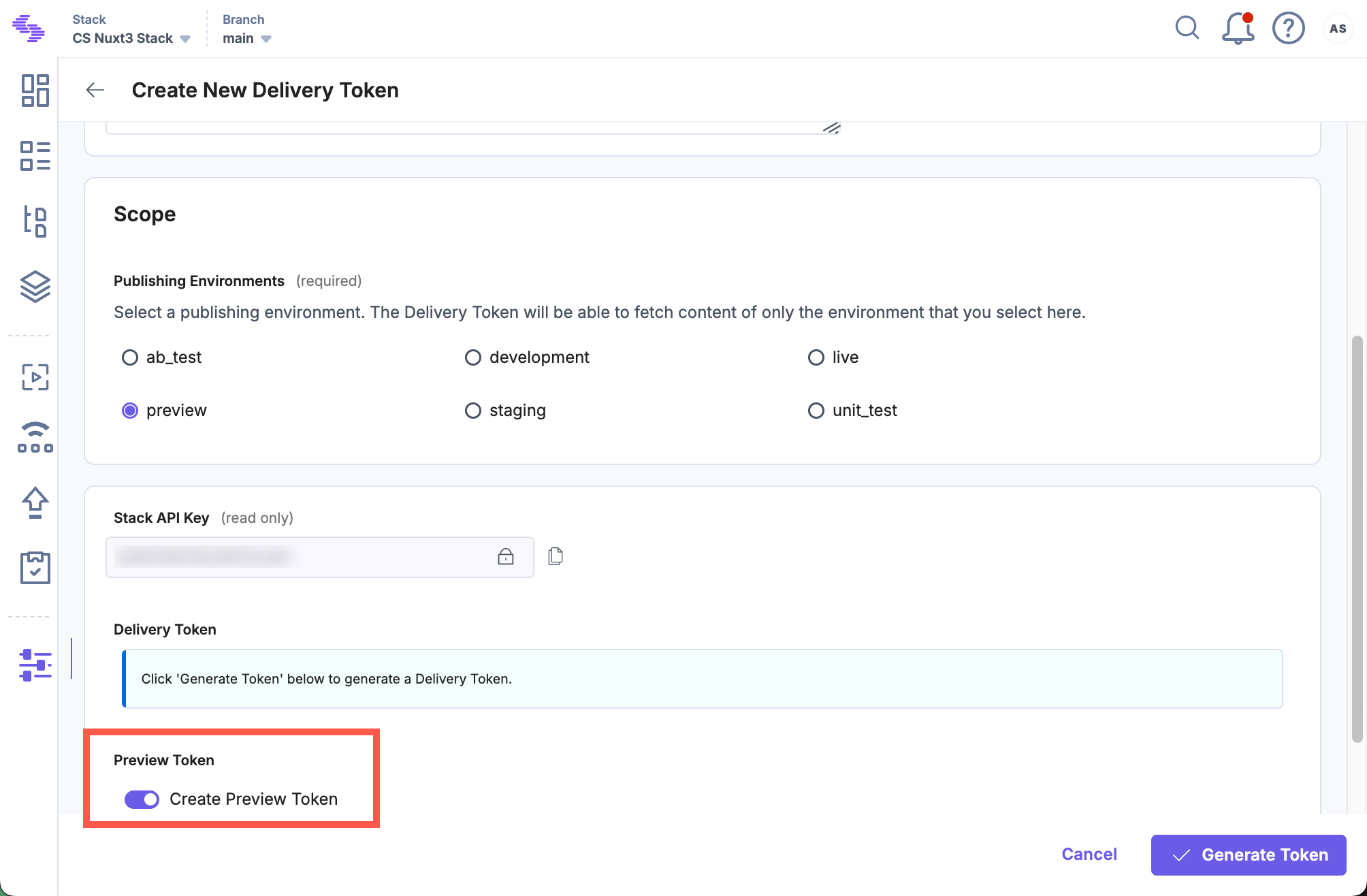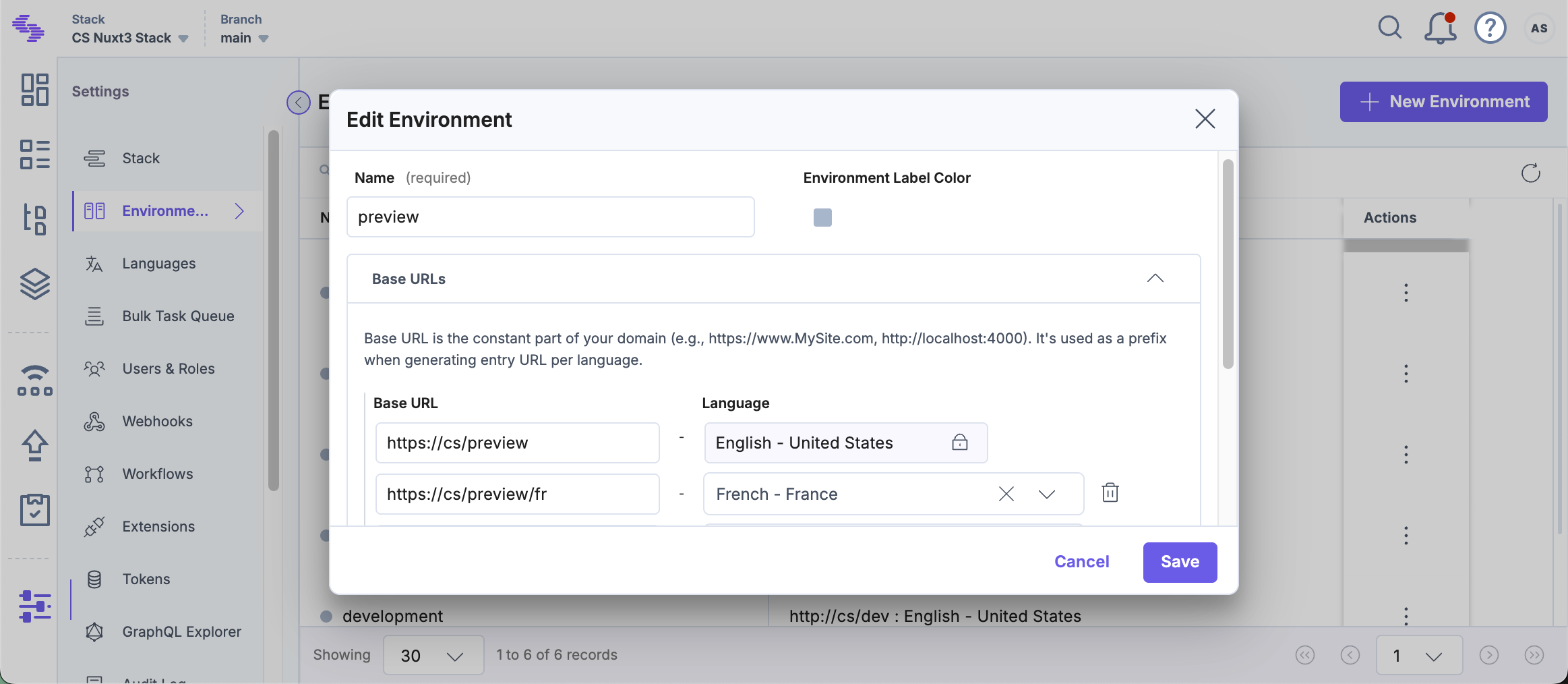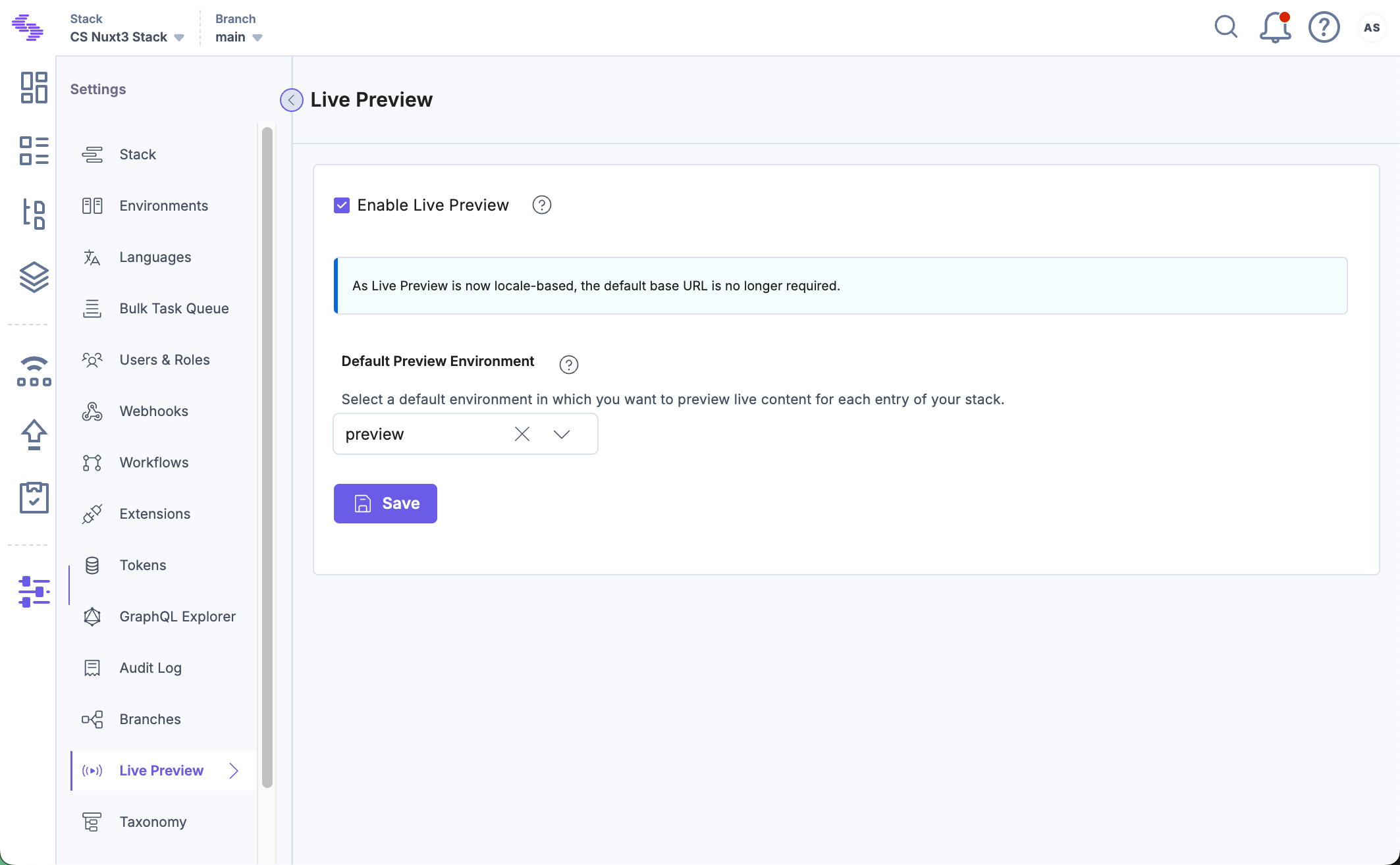Live Preview Implementation for NextJS SSR App Router
Server-side rendering (SSR) means your website’s pages are generated on the server before they reach a visitor’s browser. Instead of building the page in the browser, the server sends fully prepared HTML to display. This guide explains how to configure Live Preview for SSR websites using REST APIs.
Prerequisites
- Contentstack account
- Access to stack settings
- Preview token
- Website that uses Contentstack Delivery SDKs
- IFrame-compatible website to avoid CORS errors
Follow these steps to configure Live Preview for your NextJS SSR App router:
Set Up the Website
To enable Live Preview on your website, begin by setting up the essentials.
Generate a Preview Token
Create a preview token by navigating to Settings > Tokens > Delivery Tokens (press “alt + O” for Windows or “option key + O” for Mac).
Note: It is recommended to use a preview token for Live Preview instead of a previously utilized, read-only management token.
Each preview token is associated with a delivery token and shares access to the specific environment. If a delivery token doesn't exist, create one and enable the Create Preview Token toggle. For an existing delivery token, use the + Create Preview Token option and copy the generated token.

Update Contentstack's delivery SDK:
Add the Live Preview configuration inside the Contentstack.Stack() method when configuring Contentstack’s Delivery SDK. For example, here’s a sample configuration using the JavaScript Delivery SDK:
// utils.js import Contentstack from 'contentstack' const Stack = Contentstack.Stack({ ... // update your configs here live_preview: { preview_token: preview_token, enable: true, host: 'rest-preview.contentstack.com' //recommended }, ... })Note: For the North America endpoint, set the host parameter to rest-preview.contentstack.com. If your website is hosted on a different data center, use one of the following values:- AWS EU: eu-rest-preview.contentstack.com
- Azure NA: azure-na-rest-preview.contentstack.com
- Azure EU: azure-eu-rest-preview.contentstack.com
- GCP NA: gcp-na-rest-preview.contentstack.com
- GCP EU: gcp-eu-rest-preview.contentstack.com
Migrate to New Preview Service (recommended):
Upgrade the Contentstack SDK to its latest version to use the new preview service. In your Contentstack.Stack() initialization, replace the management_token parameter with the preview_token, as shown below:
Contentstack.Stack({ ..., live_preview: { enable: true, host: "rest-preview.contentstack.com", preview_token: "csxxxxxxxxxxxx" } })Additional Resource: For detailed information, refer to the Migrate to Preview Service documentation.
Warning: Updating to the latest SDK version won’t affect your current configuration. However, you may experience limited performance improvements in Live Preview for referenced entries and certain operations unless you update both the host and token as shown above.
Install and Initialize the Live Preview Utils SDK:
Use the Live Preview Utils SDK to listen for content updates and fetch real-time preview data on the client side.
Install the SDK using one of the following methods:
- Via npm:
Install the Live Preview Utils SDK package via npm by running the following command:
npm install @contentstack/live-preview-utils@contentstack/utils
Initialize the SDK using the init() method to set up event listeners for content updates:
import ContentstackLivePreview from "@contentstack/live-preview-utils"; ContentstackLivePreview.init({ enable: true, ssr: false, stackSdk: Stack, });Note: To avoid configuration reset errors due to rerendering, place the initialization code in a separate JavaScript file.
- Via script:
Add the following script tag to your HTML file to load the Live Preview Utils SDK:
When using npm,create a separate component to initialize the Live Preview SDK. Once initialized, you can then import this component into your main page file.<script type='module'> import ContentstackLivePreview from 'https://esm.sh/@contentstack/live-preview-utils@3.0.1'; ContentstackLivePreview.init({ enable: true, ssr: false, stackSdk: Stack // Stack instance from delivery sdk }); </script>Define the SDK initialization code within a separate JavaScript file to prevent configuration resetting errors in your Live Preview setup caused by rerendering."use client"; import { useEffect } from "react"; import ContentstackLivePreview from "@contentstack/live-preview-utils"; export default function LivePreviewInitComponent() { useEffect(() => { ContentstackLivePreview.init({ enable: true, ssr: true }); }, []); return (<></>); }
- Via npm:
Set Up SDK Initialization and Data Fetching Utilities:
Create a utility file and add the SDK initialization and data fetching logic to it.
// utils.js ... import Contentstack from 'contentstack'; export function initializeContentstackDeliverySDK() { return Contentstack.Stack({ // add your config here }); } export async function getCMSData(stack, options) { return await stack.ContentType("your_content_type") .Entry("entry_uid") .toJSON() .fetch(); } ...Configure Live Preview across each webpage
Whenever you update an entry, the live preview will re-render the entire page. This allows you to implement any coding logic necessary to fetch data within the component.
// page.js import { initializeContentstackDeliverySDK, getCMSData } from "./utils.js"; import LivePreviewInitComponent from "../components/LivePreviewInitComponent"; export default async function Page({ searchParams }) { // 1. Create a new SDK client per request const stack = initializeContentstackDeliverySDK(); // 2. Pass live preview query parameters to the SDK stack.livePreviewQuery(searchParams); // 3. Fetch data using this stack instance const entryData = await getCMSData(stack, { url: "/" }); return ( <> <h1> Hello, World! {" " + entryData?.title} </h1> <LivePreviewInitComponent /> </> ); }With these steps completed, the user website is ready. Let's proceed to host the website.
Host the Website
To host a website, you can simply use launch or any other website hosting service.
Update Stack Settings
To set up Live Preview for the entries of your stack, you need to perform the following steps:
- Navigate to Settings and select Environments.
- Set the base URLs for different locales and click Update.

- Navigate to Live Preview in the left navigation panel and select the Enable Live Preview checkbox.
- Set the Default Preview Environment and click Save to save the settings.

Tip: You can also update the preview URL and environment from the preview settings available on the entry page.
You will now be able to see the Live Preview icon within all the entries of your stack and the feature will preview data from the hosted website.
Live Edit Tags for Entries (optional)
Live Edit tags allow editors to directly jump from the Live Preview pane to the corresponding content fields in the entry editor. Clicking the Edit button next to a content block automatically opens the relevant field. If the field refers to another entry, you’ll be redirected to that entry’s editor page.
Additional Resource: For detailed information on how to set up Live Edit tags, please refer to our documentation on Set Up Live Edit Tags for Entries with REST





.svg?format=pjpg&auto=webp)
.svg?format=pjpg&auto=webp)
.png?format=pjpg&auto=webp)






.png?format=pjpg&auto=webp)